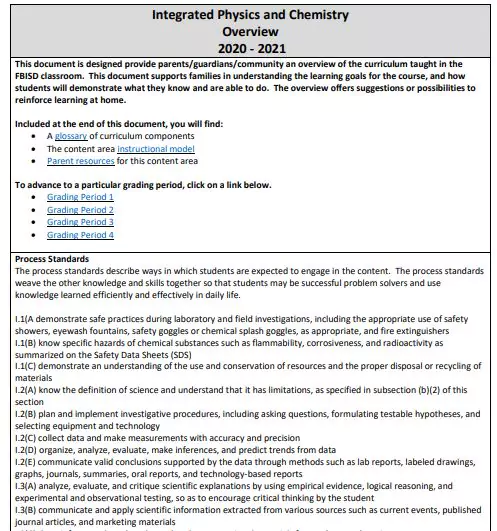‘Integrated Physics And Chemistry’ PDF Quick download link is given at the bottom of this article. You can see the PDF demo, size of the PDF, page numbers, and direct download Free PDF of ‘An Integrated Physics And Chemistry Curriculum’ using the download button.
Integrated knowledge Of Physics And Chemistry PDF Free Download

Integrated Physics And Chemistry
Process Standards
The process standards describe how students are expected to engage in the content.
The process standards weave the other knowledge and skills together so that students may be successful problem solvers and use knowledge learned efficiently and effectively in daily life.
I.1(A demonstrates safe practices during laboratory and field investigations, including appropriate use of safety showers, eyewash fountains, safety goggles or chemical splash goggles, and fire extinguishers.
I.1(B) know specific hazards of chemical substances such as flammability, corrosiveness, and radioactivity as summarized on the Safety Data Sheets (SDS)
I.1(C) demonstrates an understanding of the use and conservation of resources and the proper disposal or recycling of materials
I.2(A) know the definition of science and understand that it has limitations, as specified in subsection
(b)(2) of this section
I.2(B) Plan and implement investigative procedures, including asking questions, formulating testable hypotheses, and selecting equipment and technology
I.2(C) collect data and make measurements with accuracy and precision
I.2(D) Organize, analyze, evaluate, make inferences, and predict trends from data
I.2(E) communicates valid conclusions supported by the data through methods such as lab reports, labeled drawings, graphs, journals, summaries, oral reports, and technology‐based reports
I.3(A) Analyze, evaluate, and critique scientific explanations by using empirical evidence, logical reasoning, and experimental and observational testing, so as to encourage critical thinking by the student
I.3(B) Communicate and apply scientific information extracted from various sources such as current events, published journal articles, and marketing materials
I.3(C) draw inferences based on data related to promotional materials for products and services
I.3(D) evaluates the impact of research on scientific thought, society, and the environment
I.3(E) describes the connection between physics and chemistry and future careers
Unit Overview:
In this unit, students will review safety rules for laboratory investigations differentiate between physical and chemical properties, and use physical and chemical properties of matter to classify, describe, and identify matter.
Determine or calculate the physical properties of a substance, including boiling point, melting point, freezing point, and density.
By the end of the unit, students will be able to list and identify the physical properties of elements and chemical properties of compounds.
In 6th grade, students learned that the properties of elements and compounds do not change which is a foundational concept that will be built upon throughout this course.
At-home connections:
• Have a conversation with students about safety practices and rules/procedures that are used at home.
• With adult supervision, students can determine the density of objects by seeing if they will sink or float in water.
This can be done in a sink or large bowl containing water.
Students should not use sharp or dangerous objects and need to be mindful of the safety rules.
Unit Overview:
In this unit, students will identify an element, given the number of protons (or a diagram that contains the protons) from information on the periodic table.
Students will understand the names and chemical reactivity of the main groups on the periodic
table.
Students will learn how the elements in a group are related to each other.
IPC students will know how to find the atomic mass and atomic number from the periodic table to explain the significance of these numbers and understand what isotopes are.
Students will determine the number of valence electrons that an element contains.
In middle school, students learn to interpret the arrangement of the Periodic Table, including groups and periods, and to explain how properties are used to classify elements.
At-home connections:
• Adults can ask students to point out household items that are made from the elements on the Periodic Table (refer to a picture of a Periodic Table).
Students can identify the family in which the element belongs, the atomic number, protons, electrons, and neutrons.
In this unit, students will understand the relationship between valence electrons and bonding.
Students will determine which elements accept or donate electrons using the periodic table. Students will determine what ion any given element forms.
IPC students will write chemical formulas for ionic compounds, including those with polyatomic ions.
Students will distinguish between ionic and covalent compounds and determine the properties of each type of compound.
Students will draw Lewis and Bohr diagrams to illustrate ionic and covalent bonding At home connections:
• Students can give examples or search the internet for pictures of household items that have chemically bonded together.
For example, students can explain which elements are bonded together to make table salt.
Students should not complete a lab investigation or use any household chemicals.
| Author | – |
| Language | English |
| No. of Pages | 14 |
| PDF Size | 4 MB |
| Category | Subject |
| Source/Credits | fortbendisd.com |
Related PDFs
The Problems Of Philosophy PDF By Bertrand Russell
Integrated Knowledge of Physics And Chemistry PDF Free Download
